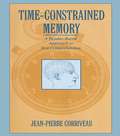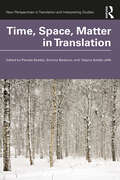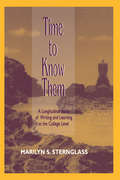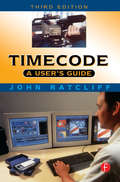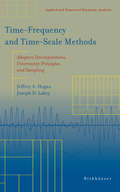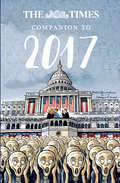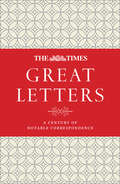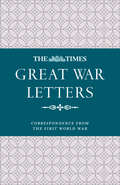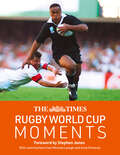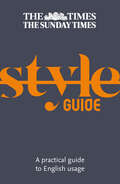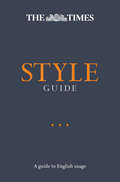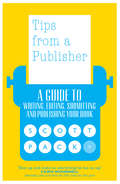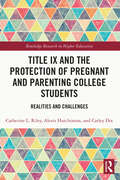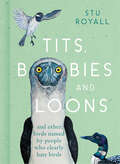- Table View
- List View
Time-constrained Memory: A Reader-based Approach To Text Comprehension
by Jean-Pierre CorriveauThis book tries to answer the question posed by Minsky at the beginning of The Society of Mind: "to explain the mind, we have to show how minds are built from mindless stuff, from parts that are much smaller and simpler than anything we'd considered smart." The author believes that cognition should not be rooted in innate rules and primitives, but rather grounded in human memory. More specifically, he suggests viewing linguistic comprehension as a time-constrained process -- a race for building an interpretation in short term memory. After reviewing existing psychological and computational approaches to text understanding and concluding that they generally rely on self-validating primitives, the author abandons this objectivist and normative approach to meaning and develops a set of requirements for a grounded cognitive architecture. He then goes on to explain how this architecture must avoid all epistemological commitments, be tractable both with respect to space and time, and, most importantly, account for the diachronic and non-deterministic nature of comprehension. In other words, a text may or may not lead to an interpretation for a specific reader, and may be associated with several interpretations over time by one reader. Throughout the remainder of the book, the author demonstrates that rules for all major facets of comprehension -- syntax, reference resolution, quantification, lexical and structural disambiguation, inference and subject matter -- can be expressed in terms of the simple mechanistic computing elements of a massively parallel network modeling memory. These elements, called knowledge units, work in a limited amount of time and have the ability not only to recognize but also to build the structures that make up an interpretation. Designed as a main text for graduate courses, this volume is essential to the fields of cognitive science, artificial intelligence, memory modeling, text understanding, computational linguistics and natural language understanding. Other areas of application are schema-matching, hermeneutics, local connectionism, and text linguistics. With its extensive bibliography, the book is also valuable as supplemental reading for introductory undergraduate courses in cognitive science and computational linguistics.
Time Division Multiple Access For Vehicular Communications (SpringerBriefs in Computer Science)
by Hassan Aboubakr Omar Weihua ZhuangThis brief focuses on medium access control (MAC) in vehicular ad hoc networks (VANETs), and presents VeMAC, a novel MAC scheme based on distributed time division multiple access (TDMA) for VANETs. The performance of VeMAC is evaluated via mathematical analysis and computer simulations in comparison with other existing MAC protocols, including the IEEE 802.11p standard. This brief aims at proposing TDMA as a suitable MAC scheme for VANETs, which can support the quality-of-service requirements of high priority VANET applications.
Time-Domain Beamforming and Blind Source Separation: Speech Input in the Car Environment (Lecture Notes in Electrical Engineering #3)
by Julien Bourgeois Wolfgang MinkerThis book addresses the problem of separating spontaneous multi-party speech by way of microphone arrays (beamformers) and adaptive signal processing techniques. It is written is a concise manner and an effort has been made such that all presented algorithms can be straightforwardly implemented by the reader. All experimental results have been obtained with real in-car microphone recordings involving simultaneous speech of the driver and the co-driver.
Time Domain Methods in Electrodynamics: A Tribute to Wolfgang J. R. Hoefer (Springer Proceedings in Physics #121)
by Peter Russer Uwe SiartTime for Adventure: A Grammar Tales Book To Support Grammar And Language Development In Children (Grammar Tales)
by Jessica HabibJem’s friend, Lottie, has come to play, but Jem is taking all the toys for herself. She learns that adventures are more fun when you share. Targeting Subject-Verb-Object sentences and pronouns, this book provides repeated examples of early developing syntax and morphology which will engage and excite the reader while building pre-literacy skills and make learning fun, as well as exposing children to multiple models of the target grammar form. Perfect for a speech and language therapy session, this book is an ideal starting point for targeting client goals and can also be enjoyed at school or home to reinforce what has been taught in the therapy session.
Time for Adventure: A Grammar Tales Book to Support Grammar and Language Development in Children (Grammar Tales)
by Jessica HabibJem’s friend, Lottie, has come to play, but Jem is taking all the toys for herself. She learns that adventures are more fun when you share. Targeting Subject-Verb-Object sentences and pronouns, this book provides repeated examples of early developing syntax and morphology which will engage and excite the reader while building pre-literacy skills and make learning fun, as well as exposing children to multiple models of the target grammar form. Perfect for a speech and language therapy session, this book is an ideal starting point for targeting client goals and can also be enjoyed at school or home to reinforce what has been taught in the therapy session.
Time, Space, Matter in Translation (New Perspectives in Translation and Interpreting Studies)
by Pamela Beattie Simona Bertacco Tatjana Soldat-JaffeTime, Space, Matter in Translation considers time, space, and materiality as legitimate habitats of translation. By offering a linked series of interdisciplinary case studies that show translation in action beyond languages and texts, this book provides a capacious and innovative understanding of what translation is, what it does, how, and where. The volume uses translation as a means through which to interrogate processes of knowledge transfer and creation, interpretation and reading, communication and relationship building—but it does so in ways that refuse to privilege one discipline over another, denying any one of them an entitled perspective. The result is a book that is grounded in the disciplines of the authors and simultaneously groundbreaking in how its contributors incorporate translation studies into their work. This is key reading for students in comparative literature—and in the humanities at large—and for scholars interested in seeing how expanding intellectual conversations can develop beyond traditional questions and methods.
Time, Space, Matter in Translation (New Perspectives in Translation and Interpreting Studies)
by Pamela Beattie Simona Bertacco Tatjana Soldat-JaffeTime, Space, Matter in Translation considers time, space, and materiality as legitimate habitats of translation. By offering a linked series of interdisciplinary case studies that show translation in action beyond languages and texts, this book provides a capacious and innovative understanding of what translation is, what it does, how, and where. The volume uses translation as a means through which to interrogate processes of knowledge transfer and creation, interpretation and reading, communication and relationship building—but it does so in ways that refuse to privilege one discipline over another, denying any one of them an entitled perspective. The result is a book that is grounded in the disciplines of the authors and simultaneously groundbreaking in how its contributors incorporate translation studies into their work. This is key reading for students in comparative literature—and in the humanities at large—and for scholars interested in seeing how expanding intellectual conversations can develop beyond traditional questions and methods.
Time To Know Them: A Longitudinal Study of Writing and Learning at the College Level
by Marilyn S. SternglassIn a time of declining resources in institutions of higher education, we grapple with how priorities are to be set for the limited resources available. Most vulnerable are those students labeled underprepared by colleges and universities. Should we argue that the limited resources available ought to be used to support these students through their undergraduate years? And, if we decide that we want to do that, what evidence of their potential for success can we provide that will justify the use of these resources? Through longitudinal research that follows students who have been so labeled over all their college years, we can begin to find answers to these questions. Time to Know Them is the first book that follows the experiences of a group of students over their entire academic experience. No previous studies have brought together the factors incorporated in this study: *examining writing and learning on a true longitudinal basis; *studying a multicultural urban population; *investigating the relationship between writing and learning by examining papers written over time for regularly assigned academic courses across a range of disciplines; and *taking into consideration non-academic factors that influence academic performance such as race, gender, socio-economic status, and ideological orientation. Through interviews twice a semester over six years, the collection of papers written for all courses, observations of instructional settings, and analysis of required institutional tests of writing, the author has been able to pull together a more complete picture of writing and intellectual development over the college years than has previously been available in any study. Students are seen to acquire the ability to handle more complex reasoning tasks as they find themselves in more challenging intellectual settings and where risk-taking and exploration of new ideas are valued. The integration of students' previous life experiences into their academic studies allows them to analyze, critique, modify, and apply their previously held world views to their new learning. These changes are seen to occur over time with instructional settings and support providing key roles in writing development. Personal factors in students' lives present difficulties that require persistence and dedication to overcome. Never before have the complexities of real individual lives as they affect academic performance been so clearly presented.
Time To Know Them: A Longitudinal Study of Writing and Learning at the College Level
by Marilyn S. SternglassIn a time of declining resources in institutions of higher education, we grapple with how priorities are to be set for the limited resources available. Most vulnerable are those students labeled underprepared by colleges and universities. Should we argue that the limited resources available ought to be used to support these students through their undergraduate years? And, if we decide that we want to do that, what evidence of their potential for success can we provide that will justify the use of these resources? Through longitudinal research that follows students who have been so labeled over all their college years, we can begin to find answers to these questions. Time to Know Them is the first book that follows the experiences of a group of students over their entire academic experience. No previous studies have brought together the factors incorporated in this study: *examining writing and learning on a true longitudinal basis; *studying a multicultural urban population; *investigating the relationship between writing and learning by examining papers written over time for regularly assigned academic courses across a range of disciplines; and *taking into consideration non-academic factors that influence academic performance such as race, gender, socio-economic status, and ideological orientation. Through interviews twice a semester over six years, the collection of papers written for all courses, observations of instructional settings, and analysis of required institutional tests of writing, the author has been able to pull together a more complete picture of writing and intellectual development over the college years than has previously been available in any study. Students are seen to acquire the ability to handle more complex reasoning tasks as they find themselves in more challenging intellectual settings and where risk-taking and exploration of new ideas are valued. The integration of students' previous life experiences into their academic studies allows them to analyze, critique, modify, and apply their previously held world views to their new learning. These changes are seen to occur over time with instructional settings and support providing key roles in writing development. Personal factors in students' lives present difficulties that require persistence and dedication to overcome. Never before have the complexities of real individual lives as they affect academic performance been so clearly presented.
Time to Talk: Implementing Outstanding Practice in Speech, Language and Communication (nasen spotlight)
by Jean GrossTime to Talk provides a powerful and accessible resource for practitioners working to improve children’s language and communication skills. Showcasing effective approaches in schools and settings across the country from the early years through primary and secondary education, it summarises research on what helps children and young people develop good communication skills, and highlights the importance of key factors: a place to talk, a reason to talk and support for talk. This timely second edition has been fully updated to reflect Pupil Premium, curriculum, assessment and special needs reforms, and can be used by individual practitioners as well as supporting a whole-school or setting approach to spoken language. It includes: whole-class approaches to developing all children and young people’s speaking and listening skills; ‘catch-up’ strategies for those with limited language; ways of differentiating the curriculum for those with difficulties; ways in which settings and schools can develop an effective partnership with specialists to help children with more severe needs; models schools can use to commission their own speech and language therapy services; examples of good practice in supporting parents/carers to develop their children’s language skills; and answers to practitioners’ most frequently asked questions about speech and language. Now in full-colour, this practical and engaging book is for all who are concerned about how to help children and young people with limited language and communication skills – school leaders, teachers, early-years practitioners, and the speech and language therapists they work with.
Time to Talk: Implementing Outstanding Practice in Speech, Language and Communication (nasen spotlight)
by Jean GrossTime to Talk provides a powerful and accessible resource for practitioners working to improve children’s language and communication skills. Showcasing effective approaches in schools and settings across the country from the early years through primary and secondary education, it summarises research on what helps children and young people develop good communication skills, and highlights the importance of key factors: a place to talk, a reason to talk and support for talk. This timely second edition has been fully updated to reflect Pupil Premium, curriculum, assessment and special needs reforms, and can be used by individual practitioners as well as supporting a whole-school or setting approach to spoken language. It includes: whole-class approaches to developing all children and young people’s speaking and listening skills; ‘catch-up’ strategies for those with limited language; ways of differentiating the curriculum for those with difficulties; ways in which settings and schools can develop an effective partnership with specialists to help children with more severe needs; models schools can use to commission their own speech and language therapy services; examples of good practice in supporting parents/carers to develop their children’s language skills; and answers to practitioners’ most frequently asked questions about speech and language. Now in full-colour, this practical and engaging book is for all who are concerned about how to help children and young people with limited language and communication skills – school leaders, teachers, early-years practitioners, and the speech and language therapists they work with.
Timecode A User's Guide: A user's guide (Music Technology Ser.)
by J. RatcliffRecent radical changes in timecode technology, location shooting and post-production working practices have been brought about by the fragmentation of the television programme making industry and by a dramatic increase in affordable digital transmission and editing equipment and systems.With the expansion of non-traditional television service producers (cable, satellite and video-on-demand) almost anything hoes as far as shooting and editing formats are concerned. Timecode: A User's Guide is an indispensable reference for anyone needing to get to grips with the many aspects of timecode, whether in-house or on location.Taking into account these changes this book has now been brought completely up to date to include:* timecode and DVD, LTC & VITC in HANC packets in the serial digital TV interfaces * timecode in IEEE1395 (Firewire)* timecode and digital video cassettes* new recording formats of DVD, DV mini cassettes and D6 are included* 4:3 scanning for wide-screen films - standards updated* new material to cover new working practices* new appendices to cover the global LF time data transmissions and time data embedded in BBC transmissionsAdvice is also given on avoiding and remedying faults and errors.
Timecode A User's Guide: A user's guide
by J. RatcliffRecent radical changes in timecode technology, location shooting and post-production working practices have been brought about by the fragmentation of the television programme making industry and by a dramatic increase in affordable digital transmission and editing equipment and systems.With the expansion of non-traditional television service producers (cable, satellite and video-on-demand) almost anything hoes as far as shooting and editing formats are concerned. Timecode: A User's Guide is an indispensable reference for anyone needing to get to grips with the many aspects of timecode, whether in-house or on location.Taking into account these changes this book has now been brought completely up to date to include:* timecode and DVD, LTC & VITC in HANC packets in the serial digital TV interfaces * timecode in IEEE1395 (Firewire)* timecode and digital video cassettes* new recording formats of DVD, DV mini cassettes and D6 are included* 4:3 scanning for wide-screen films - standards updated* new material to cover new working practices* new appendices to cover the global LF time data transmissions and time data embedded in BBC transmissionsAdvice is also given on avoiding and remedying faults and errors.
Time‒Frequency and Time‒Scale Methods: Adaptive Decompositions, Uncertainty Principles, and Sampling (Applied and Numerical Harmonic Analysis)
by Jeffrey A. HoganDeveloped in this book are several deep connections between time-frequency (Fourier/Gabor) analysis and time-scale (wavelet) analysis, emphasizing the powerful adaptive methods that emerge when separate techniques from each area are properly assembled in a larger context. While researchers at the forefront of these areas are well aware of the benefits of such a unified approach, there remains a knowledge gap in the larger community of practitioners about the precise strengths and limitations of Fourier/Gabor analysis versus wavelets. This book fills that gap by presenting the interface of time-frequency and time-scale methods as a rich area of work. "Foundations of Time-Frequency and Time-Scale Methods" will be suitable for applied mathematicians and engineers in signal/image processing and communication theory, as well as researchers and students in mathematical analysis, signal analysis, and mathematical physics.
The Times Companion to 2017: The Best Writing From The Times
by The TimesA year of political upheaval, sporting thrills, and continuing global conflict. The Times Companion to 2017 is a selection of authoritative and entertaining writing on politics, war, culture, sport and current affairs from the world’s most famous newspaper.
The Times Great Letters: Notable Correspondence To The Newspaper
by James OwenThe Times has the most famous letters page of any newspaper. This delightful selection of over 300 items of correspondence over the last century shows precisely why.
The Times Great War Letters: Correspondence During The First World War
by James Owen Samantha WyndhamSelection of more than 300 letters published by The Times newspaper between 1914 and 1918, as its readers and the nation alike endured the ordeal of the First World War.
The Times Rugby World Cup Moments
by David Hands Michael Lynagh Anna RichardsPairing epic sports photography with articles from The Times and The Sunday Times archive, this volume brings together 100 of the most iconic moments from World Cup history.
The Times Style Guide: A Practical Guide To English Usage
by CollinsThe official style guide followed by The Times and The Sunday Times. Uncover the rules, conventions and policies on spelling, grammar and usage followed by the journalists, contributors and editors working on the Times and Sunday Times newspapers. Now updated with all the latest policy decisions.
The Times Style Guide
by UnknownUncover the rules, conventions and policies on spelling, grammar and usage followed by the journalists, contributors and editors working on the Times newspaper.
Tips from a Publisher: A Guide to Writing, Editing, Submitting and Publishing Your Book
by Scott PackFrom a handy introduction to how the publishing world works, and how authors fit into it, to practical tips on writing your book, strategies for editing and re-writing, Tips from a Publisher is an indispensable guide for authors.Helping you create the perfect submission and telling you the truth about what happens once you get published, it is crammed full of common-sense advice, and some trade secrets, that no aspiring writer should be without.'Shut up and listen to everything he has to say’ – Caimh McDonnell, bestselling author of The Dublin Trilogy‘Part instruction manual, part sat nav, part friendly arm round the shoulder: this is the book every aspiring writer needs to own’ – John Mitchinson, co-founder, Unbound‘A book-shaped boot camp for emerging writers… essential reading’ – Judith Heneghan, director, Winchester Writers' Festival ‘Scott knows the publishing industry inside-out and whenever I work with him, I know my authors are in good hands’ – Charlotte Seymour, literary agent ‘I wouldn't trust anyone else to give me advice, he really knows his stuff!’ – Valerie Brandes, founder, Jacaranda Books‘The best editor I've ever worked with’ – Ray Robinson, author of The Mating Habits of Stags
Title IX and the Protection of Pregnant and Parenting College Students: Realities and Challenges (Routledge Research in Higher Education)
by Catherine L. Riley Alexis Hutchinson Carley DixThis book explores the discrepancies among what protections Title IX provides to pregnant and parenting students, what colleges communicate, and what pregnant and parenting students actually experience. To actually protect pregnant and parenting students, the authors argue that a school must provide multifaceted support that is effectively communicated to an entire campus community, including students who are parenting, who are pregnant, and who may become pregnant. The first part of the book portrays the realities of pregnancy and parenting in college. The chapters illuminate related Title IX applications, population demographics, how unplanned pregnancies in college occur, and physical and mental health challenges that these students often experience. The authors then discuss what compliance with Title IX legally entails and why meeting it is often an afterthought. In the second half of the book, the authors use mixed-methods research to map the compliance landscapes of three schools in the southeast as examples: a large state school, a mid-size private university, and a small private college. Offering eye-opening interviews with pregnant and parenting students, interdisciplinary research, and proposals for multifaceted support and communication on college campuses, this volume will engage students, scholars, and activists with an interest in higher education administration, educational policy, reproductive health, bioethics, gender studies, and rhetoric.
Title IX and the Protection of Pregnant and Parenting College Students: Realities and Challenges (Routledge Research in Higher Education)
by Catherine L. Riley Alexis Hutchinson Carley DixThis book explores the discrepancies among what protections Title IX provides to pregnant and parenting students, what colleges communicate, and what pregnant and parenting students actually experience. To actually protect pregnant and parenting students, the authors argue that a school must provide multifaceted support that is effectively communicated to an entire campus community, including students who are parenting, who are pregnant, and who may become pregnant. The first part of the book portrays the realities of pregnancy and parenting in college. The chapters illuminate related Title IX applications, population demographics, how unplanned pregnancies in college occur, and physical and mental health challenges that these students often experience. The authors then discuss what compliance with Title IX legally entails and why meeting it is often an afterthought. In the second half of the book, the authors use mixed-methods research to map the compliance landscapes of three schools in the southeast as examples: a large state school, a mid-size private university, and a small private college. Offering eye-opening interviews with pregnant and parenting students, interdisciplinary research, and proposals for multifaceted support and communication on college campuses, this volume will engage students, scholars, and activists with an interest in higher education administration, educational policy, reproductive health, bioethics, gender studies, and rhetoric.
Tits, Boobies and Loons: And Others Birds Named By People Who Clearly Hate Birds
by Stu RoyallFrom the monotonous lark to the rough-faced shag, these poor birds have us all asking: ARE ORNITHOLOGISTS OK?
